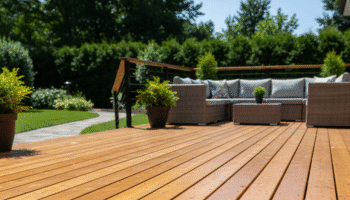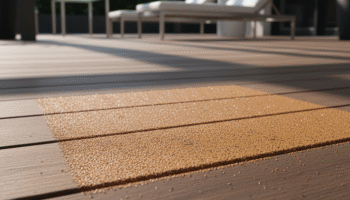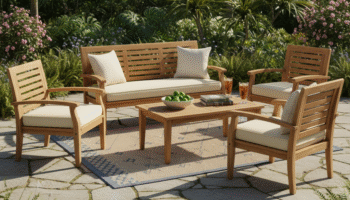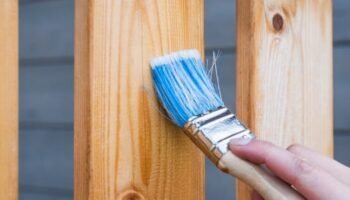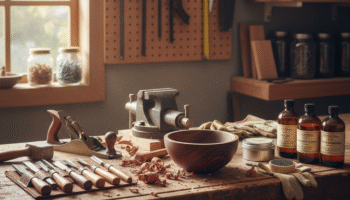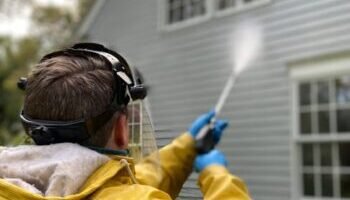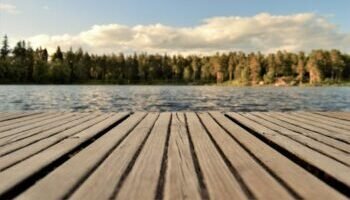Oxalic Acid vs. Sodium Percarbonate
Mini-plan (what you’ll get):
- Layman-friendly chemistry so you pick the right deck cleaner the first time.
- A clear, pro-tested two-step method with exact ratios, dwell times, and safety.
- Head-to-head scenarios, cost per square foot, common mistakes, and eco notes.
When deck cleaning goes wrong, it’s almost always because the wrong chemical was used for the wrong stain. After thousands of deck cleanings, I can usually tell which chemical touched the wood just by the afterlook. Most DIYers reach for a one-size-fits-all cleaner and wonder why the results are flat—or why cedar turns blotchy. This guide explains why different stains need different chemistry and exactly when to use sodium percarbonate (oxygen bleach) vs oxalic acid for professional, repeatable results.
Understanding Deck Cleaning Chemistry
Why Different Stains Require Different Chemicals
Think of stains in two families:
- Organic/biological soils (mold, mildew, algae, pollen, food, grime)
- Inorganic/metal/tannin issues (rust, nail/screw marks, tannin bleed, extractives discoloration—especially cedar/redwood)
Match the chemistry to the problem:
ORGANIC DIRT/MOLD → Alkaline cleaner (Sodium Percarbonate)
RUST/TANNIN/METAL MARKS → Acidic brightener (Oxalic Acid)
I see this mismatch constantly: oxygen bleach used on rust rings, or oxalic acid used to “clean” grimy boards. One won’t fix the other.
pH Levels & Wood Fiber Safety
- Sodium percarbonate solutions are alkaline (raises pH). They lift organic soils and open wood pores.
- Oxalic acid is acidic (lowers pH). It chelates iron and neutralizes the wood after alkaline cleaning, restoring a natural tone.
Balancing pH matters because extremes can rough up fibers (the “cedar fuzzies”) or lock in discoloration.
Common Deck Cleaning Misconceptions
- Myth: “Oxygen bleach cleans everything.”
Reality: It doesn’t remove rust or tannin stains—and can darken tannins unless followed by an acid brightener. - Myth: “Oxalic acid is a cleaner.”
Reality: Oxalic isn’t a cleaner. It’s a brightener/neutralizer and targeted stain remover for rust/tannins.
Sodium Percarbonate (Oxygen Bleach): Complete Profile
What Is Sodium Percarbonate?
A solid oxidizer that releases hydrogen peroxide in water. In deck terms: a gentle, wood-safe way to deep-clean organic grime without the fiber damage that chlorine bleach can cause.
How Oxygen Bleach Cleans Wood
- Oxidizes and loosens biofilms (mold/mildew/algae).
- Emulsifies dirt and food residue.
- Slightly opens pores for better rinse-out and subsequent staining.
From experience: On weathered pine or pressure-treated boards blotched by algae, oxygen bleach is the difference between “rinsed” and actually clean.
Best Uses & Applications
- General dirt & grime
- Mold/mildew/algae on shaded boards
- Food & drink spills (BBQ, grease, wine stains that haven’t set with metals)
Limitations & When It’s Not Enough
- Won’t remove rust or tannin/extractive stains.
- Can visually intensify tannin darkness without an acid follow-up.
- Not a “brightener”; won’t reverse UV graying on its own.
Top Oxygen Bleach Products
- Restore-A-Deck® Cleaner (oxygen bleach base)
- Olympic® Premium Deck Cleaner (oxygen bleach)
- Pure sodium percarbonate powder (professional concentrates)
(Choose powders/concentrates for cost control and precise dilution.)
Oxalic Acid: Deep Dive Analysis
What Is Oxalic Acid & How It Works
A crystalline organic acid that chelates iron and bonds with certain discoloration compounds (tannins), lifting them from wood surfaces and resetting color.
Rust & Tannin Stain Removal Power
- Rust from furniture feet, fasteners, and tools
- Tannin bleed on cedar/redwood and around end grain
- Iron-tannin reactions (black/blue stains) from wet metal against wood
Field note: When I see perfect ring-shaped stains under planters or metal chairs, oxalic is the first (and only) thing I reach for.
Wood Brightening Effects
Oxalic restores natural tone after alkaline cleaning, making weathered boards look “newer” and more even. It also prepares the surface for uniform stain uptake.
Safety Precautions & Handling
- Treat as toxic: goggles, chemical-resistant gloves, respirator, long sleeves.
- Mix outdoors, label sprayers, keep away from kids/pets.
- Protect plants/soil with pre-wetting and tarps; rinse thoroughly after.
- Never mix acids with oxidizers or bleach products.
Best Oxalic Acid Deck Products
- Restore-A-Deck® Brightener
- Defy® Wood Brightener
- Pure oxalic acid crystals (budget-friendly, strong, easy to store)
Head-to-Head Comparison: Which Cleaner For What
| Stain/Problem | Sodium Percarbonate (Oxygen Bleach) | Oxalic Acid | Winner / Notes |
|---|---|---|---|
| General dirt & grime | Excellent | Not a cleaner | Oxygen bleach |
| Mold & mildew | Excellent (oxidizes biofilm) | No | Oxygen bleach |
| Rust stains & metal marks | No | Excellent (chelates iron) | Oxalic |
| Tannin bleeding/discoloration | Can darken without follow-up | Excellent | Oxalic |
| Graying & UV damage | Limited cleaning only | Brightens tone, not UV repair | Clean + brighten; stain for UV |
| Cedar “fuzzies” | Overuse/high pH can raise grain | Neutralizes & visually tightens look | Two-step (finish with oxalic) |
The Two-Step Cleaning Method (Professional Approach)
Why Cleaners Need Brighteners
Alkaline cleaners lift soils but leave wood high-pH. Oxalic neutralizes pH and removes discolorations that cleaning alone can’t touch. This two-step is what separates amateur results from the “did you replace the deck?” look.
Step 1: Sodium Percarbonate Clean
- Dry sweep; pre-wet plants/grass and nearby siding.
- Mix (typical starting point): 6–8 oz percarbonate powder per 1 gal warm water. Heavy soil: up to 10–12 oz/gal.
- Apply low-pressure pump sprayer.
- Dwell 10–20 minutes—keep wet; re-mist vs letting it dry.
- Agitate stubborn zones with a soft brush.
- Rinse low pressure (garden hose nozzle or <800 PSI with wide fan tip). Aim for complete residue removal.
Pro tip from the field: On north-facing boards with embedded mildew, a second light pass beats cranking up PSI (which can scar fibers).
Step 2: Oxalic Acid Brighten
- Mix 4–8 oz oxalic crystals per 1 gal water (start low; increase for deep tannin/rust).
- Apply evenly; let dwell 5–10 minutes.
- Wood should visibly brighten; stubborn rust may need a second pass.
- Rinse thoroughly until runoff runs clear.
pH Neutralization Importance
Finishing with oxalic neutralizes the percarbonate’s alkalinity, reducing fuzzing risk and stabilizing color for more even stain absorption.
Application Techniques & Best Practices
Dilution Ratios & Mixing
- Start at 6–8 oz/gal (percarbonate) and 4–8 oz/gal (oxalic).
- Hard water or heavy soil? Incrementally increase.
- Always label your sprayers “ALKALINE” and “ACID”.
Dwell Time Requirements
- Oxygen bleach: 10–20 min, never dry on surface.
- Oxalic: 5–10 min, check brightening progress at 3–5 min.
Temperature Considerations
- Best between 50–80°F (10–27°C).
- Hot sun? Work smaller sections; shade is your friend.
Rinsing Protocols
- Favor low pressure with volume.
- Rinse with the grain.
- Edges, steps, and rail undersides hold residue—double-check.
Safety Equipment & Precautions
PPE Requirements
- Goggles/face shield, nitrile or neoprene gloves, respirator, long sleeves.
- No sandals; use non-slip footwear.
Plant & Landscape Protection
- Pre-wet foliage/soil, gently tarp sensitive beds, then post-rinse.
- Remove metal decor/furniture to prevent fresh rust marks.
Runoff Considerations
- Keep out of storm drains.
- Work over grass/soil you can flush with water.
- Never mix leftover alkaline and acid solutions.
Storage & Disposal
- Store powders dry and sealed.
- Neutralize small leftovers with excess water, then dispose per local regs.
DIY Products vs. Professional Concentrates
- DIY retail mixes: Easy but pricey per square foot, limited control.
- Pro concentrates (pure powders): Lowest cost, adjustable strength, consistent performance.
In my crews, we standardize on concentrates—repeatable results and better margins.
Cost Per Square Foot Analysis (Typical Ranges)
Assumptions (for planning only—follow your product label):
- Coverage ~100–150 sq ft/gal depending on soil and texture.
| Product | Typical Mix | Estimated Cost/Gal* | Coverage/Gal | Approx. Cost/Sq Ft |
|---|---|---|---|---|
| Sodium percarbonate | 6–12 oz/gal | $2.00–$4.00 | 100–150 sq ft | $0.02–$0.04 |
| Oxalic acid | 4–12 oz/gal | $2.00–$6.00 | 100–150 sq ft | $0.02–$0.06 |
*Based on common concentrate pricing; your market may vary.
Common Chemical Cleaning Mistakes
- Using oxalic alone to “clean” a dirty deck (it won’t).
- Skipping the brightener after oxygen bleach (leaves high pH and dingy tone).
- Letting solutions dry on the surface (streaks, uneven results).
- Blasting with high PSI instead of letting chemistry work.
- Forgetting to rinse until clear (residue interferes with stain).
Alternatives: Citric Acid, TSP, & Other Options
- Citric acid: Milder brightener; decent tone reset, less punch on rust vs oxalic.
- TSP (trisodium phosphate): Strong alkaline cleaner; effective on grease but environmental restrictions in some regions; can be harsh on fibers.
- Chlorine bleach (sodium hypochlorite): Powerful sanitizer, but can damage lignin, cause fiber fuzzing, and corrode nearby metals. For deck wood, oxygen bleach is the safer go-to for organic soils.
Environmental Impact Comparison
- Oxygen bleach breaks down to oxygen, water, and soda ash—DIY favorite for responsible cleaning when used properly.
- Oxalic acid is effective but toxic—handle and rinse responsibly, mind runoff, and protect vegetation.
- Always choose lowest effective concentration, work in shade, and rinse, rinse, rinse.
Product Recommendations by Scenario (Quick Picks)
- Filmy mold/mildew & grime on PT pine: Oxygen bleach first; follow oxalic for tone.
- Rust rings from furniture/fasteners: Oxalic spot treatment after cleaning.
- Cedar/redwood blotchiness & tannin bleed: Oxygen bleach → oxalic; consider a second oxalic pass on trouble spots.
- Pre-stain prep on weathered boards: Full two-step to balance pH and even the color.
“The two-step process is what always works.” Clean with sodium percarbonate, then brighten with oxalic, then rinse to neutral—this is my non-negotiable protocol on every pro job.
Oxygen Bleach vs. Chlorine Bleach on Decks
- Oxygen bleach (sodium percarbonate): Deck-safe, effective on organic soils, minimal fiber damage when used correctly.
- Chlorine bleach: Aggressive on wood fibers and metals; can leave a brittle feel and uneven color. Save it for non-wood, non-metallic exterior sanitation tasks—not bare wood decks.
Step-by-Step: Deck Cleaning with Oxygen Bleach (Quick Guide)
- Dry sweep, protect plants.
- Mix 6–8 oz/gal; spot test.
- Apply and keep wet for 10–20 min.
- Light agitation as needed.
- Rinse low pressure thoroughly.
- Follow with oxalic brightener 4–8 oz/gal for 5–10 min; rinse to clear.
- Let wood dry 24–48 hours before staining (check local humidity).
Use oxygen bleach when the enemy is organic. Use oxalic when the enemy is rust/tannins—and to neutralize and brighten after cleaning. Combine both in a two-step and you’ll stop guessing, save hours, and get pro-grade results that take stain beautifully.
These chemistry tables work best inside a climate-driven annual plan—frame them with the Exterior Wood Care Guide and follow the inspection → clean → brighten → finish flow in the Deck Care Encyclopedia. For a practical, low-risk method without a pressure washer, see Clean a Wood Deck.
Selecting the right cleaner depends on where you are in the Deck Care Encyclopedia schedule, and long-term mildew prevention can be reinforced using Best Deck Mildew Remover.
FAQs
Can you use oxalic acid alone to clean a wood deck?
No. It’s not a cleaner. Oxalic is a brightener and stain remover for rust/tannins; clean first with oxygen bleach.
Why use oxalic acid after cleaning a deck with oxygen bleach?
To neutralize pH, remove tannin/metal discolorations, and restore color—crucial for even stain absorption.
What’s the sodium percarbonate dilution ratio for deck cleaning?
Typical starting point 6–8 oz per gallon; heavy soil up to 10–12 oz per gallon. Always spot test and follow your label.
How long to let oxalic acid sit before rinsing?
Usually 5–10 minutes. Watch for visible brightening; don’t let it dry.
Is a professional two-step deck cleaner/brightener system worth it?
Yes. It’s the most reliable path to a neutral, uniform surface that stains evenly—what pros use daily.
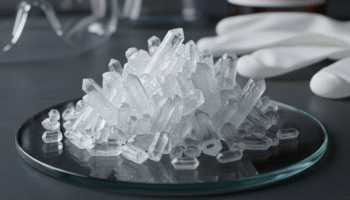
Pressure-Treated Lumber Care
When to Stain & What Products Work If you just built a brand-new green deck…
Non-Slip Deck Coatings
Grip Additives vs Textured Stains vs Strips Safety-first, solution-oriented guide to stop slip-and-fall accidents on…
Teak Outdoor Furniture Care
Teak Outdoor Furniture Care: Oil, Seal, or Leave Natural? If you’ve invested $3,000+ in a…
Best Wood Fence Stain
Penetrating vs Film-Forming, Real-World Tests, and the Longest-Lasting Picks If you’re choosing the best wood…
Cedar Siding Maintenance Schedule
Maintenance Schedule Complete Year-Round Guide Homeowners love cedar’s warm, natural look—but cedar is unforgiving if…
Deck Cleaning
How to Clean a Wood Deck Without Pressure Washing (Safe Methods) If the thought of…

